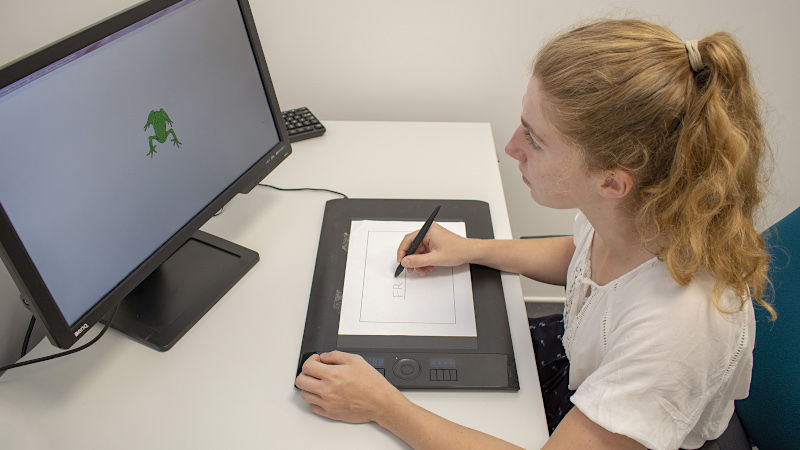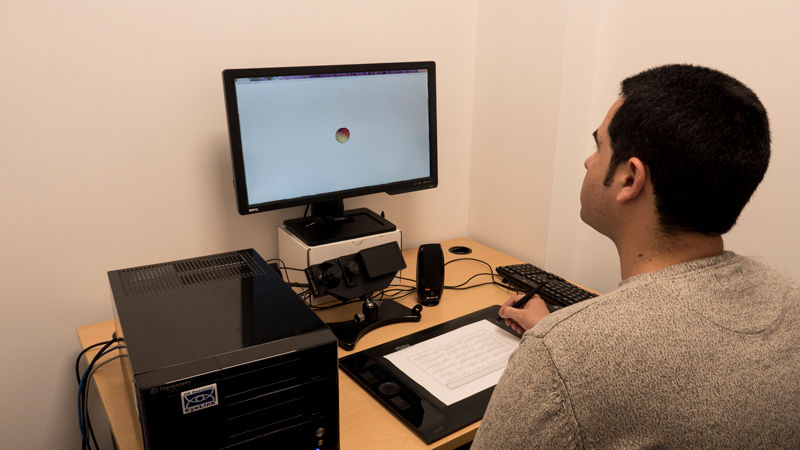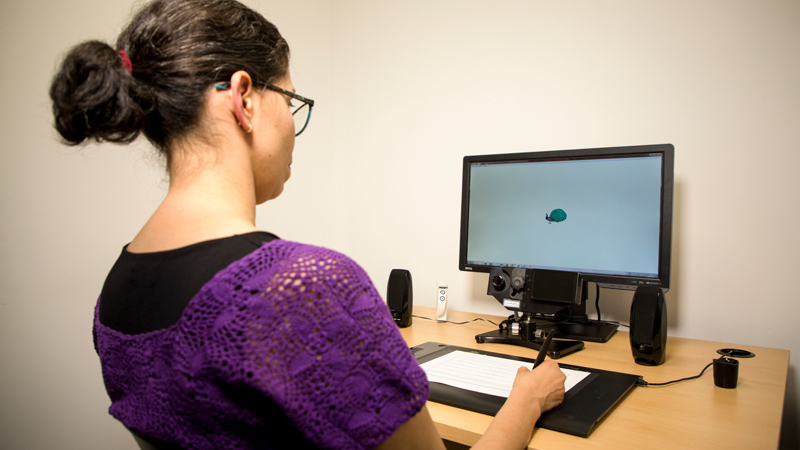Writing Lab
Contact us: afonso.o@brookes.ac.uk
The Writing Lab has a range of equipment to record and measure handwriting and keyboarding behaviour.
It is equipped with a number of Wacom Intuos graphic tablets that allow us to register the xy coordinates of the written response over 100 times a second. We use specialist software (both Ductus and Eye & Pen) for stimulus presentation and to produce measures of handwriting duration and velocity as well as pen pressure.
We also have two computers with the specialist software InputLog, which records every keystroke during typing. This allows us to measure the speed of production of different words and the revisions made while writing.
The Lab also has an EyeLink 1000 eye-tracker Experimental Builder I, available to prepare and conduct eye-tracking experiments.
We conduct internationally recognised research on typical and atypical writing development through the lifespan, with a focus on spelling and handwriting. Our lines of research include investigations of the nature of writing difficulties associated with developmental disabilities such as dyslexia and Developmental Coordination Disorder (DCD).


Assessments of handwriting speed
Anna Barnett has worked with colleagues to design a test of handwriting speed – the Detailed Assessment of Speed of Handwriting (DASH and DASH 17+; Barnett, Henderson, Scheib & Schulz, 2007, 2010). There is a version for children aged 9 to 16 years and one for those aged 17 to 25, both of which help to identify students with slow handwriting. The test is being used by Occupational Therapists, teachers and special needs tutors to measure handwriting speed and help plan how best to support those with difficulties. Work is underway in 2022 to develop an updated version, DASH-2 with new norms and some improved features.
Assessment of handwriting legibility
Demands for the production of fast and legible handwriting increase as children progress through school in the UK. Despite the considerable number of children faced with handwriting difficulties, there is a lack of practical tool to assess legibility in this population. Anna Barnett and colleagues have therefore developed the Handwriting Legibility Scale (HLS) as a quick and practical tool. Originally developed for 9-14 year olds, it has also been found to have good reliability and validity in older students aged 17-25 years..
Curriculum Based Measures (CBM) of writing assessment
Composition can be difficult and time consuming to assess in the classroom. This project, part funded by the ESRC and Leverhulme Trust, researched and designed a simple and reliable way of assessing short 5-minute compositions in order to highlight the children who were struggling with writing. The approach was based on the Curriculum Based Measures (CBM) approach to assessment developed in the USA but adapted for use in the UK. The project was successful in demonstrating the utility and reliability of the approach to identify children in primary school struggling to write compared to a more complex and time consuming commercial standardised test of written composition. The approach is recommended for classroom teachers.
Writing difficulties in children with developmental dyslexia
Developmental dyslexia refers to a specific learning disorder affecting word recognition, decoding and spelling. Although considerable research has been conducted in the last decades on the reading difficulties experienced by children with dyslexia, writing difficulties have been comparatively neglected. However, writing skills are also a fundamental part of academic and professional achievement. A series of projects investigating the writing difficulties experienced by children with dyslexia from 8 to 16 years of age have taken place and/or are ongoing. In a number of these projects, participants are asked to write words or text with different characteristics on a digitising tablet. This allows us to analyse different online measures of the written response, as writing velocity or writing onset time.
A previous project with Dr Emma Sumner was successful in demonstrating that children with dyslexia were no slower at handwriting than their peers. However, they tended to show more pauses within and between words when writing text especially around misspellings. Thus, they did take longer than their peers when writing text, so examination concessions such as extra time are required to provide an “even playing field”. It was concluded that spelling difficulty was the main factor explaining their more poorly rated written compositions in contrast to their peers.
In one of the ongoing studies within this project, children with and without dyslexia are invited to write words under articulatory suppression conditions (i.e., repeating a meaningless syllable at the same time) to detect potential differences in the use of lexical and sublexical information between both groups of children. In another ongoing project developed in collaboration with Dr Paz Suárez-Coalla from the University of Oviedo (Spain), we are investigating how spelling and handwriting difficulties may influence the development of speed in other graphic skills such as drawing and tracing.
Writing difficulties in adults with developmental dyslexia
Writing difficulties associated to developmental dyslexia do not seem to resolve with time. In fact, spelling difficulties are one of the most frequent complains among adults with this learning difficulty. Previous research published by members of our team has shown that these difficulties are not identical to those observed in children with dyslexia. Within this line of research, we work to clarify which impairments are overcome in adulthood by mere frequent exposure to written language and which difficulties persist even in highly educated adults with dyslexia.
Recent work includes a survey regarding the provision of examination concessions for students with dyslexia in Higher Education and a study of the predictors of writing ability in adults with dyslexia, with a particular focus on the role of poor spelling in their continuing difficulties. Do universities allow student with dyslexia access to tools such as spell check when they use word processors in examinations? In her PhD project in this area, Dr Lynsey O'Rourke found that the automatic underline provided by spellcheck encourages less efficient editing behaviour than when spellcheck is not activated in HE students with and without dyslexia. Less efficient editing behaviour may be more detrimental to students with dyslexia than to their peers, as they will tend to produce more underlined errors.
Writing difficulties in children and adults with language difficulties
This is an ongoing project that builds on previous work funded by the Leverhulme and ESRC. Recent projects include capturing the drivers of writing performance in struggling writers, analysis of spelling morphologically complex words and examination of the use of verbs in the writing of children with language difficulties.
Writing difficulties in secondary school children with handwriting difficulties
Some children have difficulties at secondary school because their handwriting is slow and/or hard to read. Typing is sometimes available as an alternative. We have funding from the UK Occupational Therapy Research foundation as part of their Research Priority Funding Round to carry out some research in this area. In our earlier research we have surveyed and interviewed both teachers and Occupational Therapists working in secondary schools to ask about the support offered for children with handwriting difficulties.


Phonological and orthographic processes in English spelling
English is a language with numerous and complicated spelling rules and exceptions. Children need extensive training to acquire it and most adult English speakers struggle with the spelling of a number of words. This is in part due to the absence of one-to-one correspondences between sounds and letters, with most phonemes having more than one potential spelling. Research has shown that the peculiarities of English make difficult the generalisation of findings obtained in other languages.
In this project, we investigate to what extent findings obtained in other languages can be applied to English language, including the effects of semantic, phonological and orthographic variables.
Writing in English as an additional language
In a world in which professional and academic mobility across different countries has become fairly common, the number of non-native English speakers who need to learn to write in English as an additional language (EAL) continues to growth in UK. How the rules of the native orthography interact with those of English during writing acquisition? Which characteristics of the first language may benefit and which may hinder English learning? What are the main obstacles that children and adults need to overcome to be effective writers of English as an additional language?
In this project, we will address these questions by comparing the effect of different linguistic variables on the writing productions of learners of EAL who are native speakers of different languages. In an ongoing international project in collaboration with Prof Carlos J. Álvarez (Universidad de La Laguna, Spain), we are studying how the characteristics of their first language affects the ability to spell in English of Spanish speakers with different levels of English proficiency.
The role of the phonological loop and the visual sketchpad in handwriting
It is well known that working memory processes are recruited during writing production. However, it is unclear how different components of working memory contribute to the diverse processes involved in handwriting.
In this ongoing project, we focus on the role played by the phonological loop and the visuospatial sketchpad during handwriting. It is assumed that both components of the working memory system will be recruited during writing production, but they will affect different aspects of the production process. In a dual-task paradigm, participants are asked to write words on a digitising tablet while they perform diverse concurrent tasks.
Serial order in spelling
Spelling requires the production of a series of letters in the correct order. How exactly the identity of a letter is linked to a particular position in the word is a question that has not been studied in depth until very recently, mainly due to methodological difficulties.
In this project, we explore different paradigms to investigate how serial order is coded in orthographic representations. In an ongoing study within this project, we focus on the production of words with repeated letters to clarify how the spelling system processes the occurrence of the same letter in more than one position.

